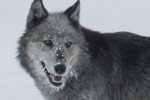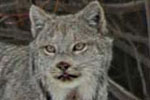The U.S. Fish and Wildlife Service (USFWS) is proposing to end protection for all gray wolves (Canis lupus) in the lower 48 states, save for a small population of Mexican wolves in New Mexico, reports the Los Angeles Times. The proposal comes two years after wolves were removed from the Endangered Species Act (ESA) in western states by a legislative rider on a budget bill, and soon after in the midwest. Since then hunting and trapping has killed over 1,500 wolves in these two regions.
Wolves were largely eradicated from most of the lower 48 states by the mid-20th Century, although a small population hung on in northern Minnesota. In 1973 wolves became protected under the Endangered Species Act; with this formal protection, wolves began moving back into the Rockies from Canada, and then in 1995 conservationists began re-wilding Yellowstone National Park with wolves. Since then wolves have made an astounding comeback, moving across the Rockies even so far as California, Oregon, and Washington, while in the midwest, they expanded to Minnesota and Wisconsin.
According to the USFWS, wolves now number around 5,000 individuals (the bulk of them still in northern Minnesota). However, this is only 2 percent of the wolf’s historic population estimated at 250,000 animals when Europeans arrived. Moreover, wolves have by no means returned to their full historic range. But many ranchers complain that wolves are responsible for killing livestock, while hunters allege that wolves are depleting elk herds.
Complete delisting from the ESA would mean management of wolf populations would move from government protection to states, which to date have largely decided to proceed with regulated hunting and trapping seasons.
The return of wolves to Yellowstone National Park proved to scientists just how important top predators are to ecosystems. Wolves kept elk at bay, allowing forests, especially along riverbeds, to grow after decades of over-grazing. The return of these stream-side forests meant an increase in songbirds and biodiversity. Meanwhile, beavers returned for the first time in decades, having forests to make dams from. Although scientists have worked hard to make the case that wolves are key to these ecosystems, many still oppose the animals’ reintroduction. In addition while wolf attacks are incredibly rare, the animals are still feared.
Related articles
Over 1,500 wolves killed in the contiguous U.S. since hunting legalized

(02/06/2013) Hunters and trappers have killed approximately 1,530 wolves over the last 18 months in the contiguous U.S., which excludes Alaska. After being protected under the Endangered Species Act (ESA) for 38 years, gray wolves (Canis lupus) were stripped of their protected states in 2011 by a legislative rider (the only animal to ever be removed in this way). Hunting and trapping first began in Montana and Idaho and has since opened in Wyoming, Minnesota, and Wisconsin.
Controversial wolf hunt moves to the Midwest, 196 wolves killed to date

(11/14/2012) The hugely controversial wolf hunt in the U.S. has spread from the western U.S. (Montana, Idaho, and Wyoming) to the Midwest (Minnesota and Wisconsin) this year. Although the wolf hunt is less than a month old in the region—and only eleven days old in Minnesota—196 animals so far have been shot. As in the west, the wolf hunt has raised hackles among environmentalists along with fierce defenders among hunters. Wolves, which were protected under the the Endangered Species Act (ESA) since 1973, were stripped of that status by legislation in 2009, opening the door—should a state choose—to trophy hunting.
Buffer zones key to survival of maned wolf

(09/17/2012) Known for its abnormally long lanky legs, its reddish-orange coat, and its omnivorous diet, the maned wolf (Chrysocyon brachyurus) is one of the more beautiful and bizarre predators of South America. However its stronghold, the Brazilian Cerrado, is vanishing rapidly to industrialized agriculture and urban development. Now, a new study in mongabay.com’s open access journal Tropical Conservation Science reveals the key role of buffer zones and unprotected areas in keeping the maned wolf from extinction in the Cerrado savannah, where only 2 percent of the ecosystem is under protection.
The heroic wolf: are wolves the key to saving the Canada lynx?

(08/31/2011) In 2000 the Canada lynx (Lynx canadensis) was listed as threatened under the US Endangered Species Act (ESA). While remaining stable in Canada and Alaska, the Canada lynx population had essentially collapsed in much of the continental US, excluding Alaska. Aside from habitat loss, one of the main factors imperiling the medium-sized wild cat was a decline in prey, specifically snowshoe hares (Lepus americanus). Researchers have now come up with an innovative way to aid hungry lynx in the US: wolves.
Decline in top predators and megafauna ‘humankind’s most pervasive influence on nature’

(07/14/2011) Worldwide wolf populations have dropped around 99 percent from historic populations. Lion populations have fallen from 450,000 to 20,000 in 50 years. Three subspecies of tiger went extinct in the 20th Century. Overfishing and finning has cut some shark populations down by 90 percent in just a few decades. Though humpback whales have rebounded since whaling was banned, they are still far from historic numbers. While some humans have mourned such statistics as an aesthetic loss, scientists now say these declines have a far greater impact on humans than just the vanishing of iconic animals. The almost wholesale destruction of top predators—such as sharks, wolves, and big cats—has drastically altered the world’s ecosystems, according to a new review study in Science. Although researchers have long known that the decline of animals at the top of food chain, including big herbivores and omnivores, affects ecosystems through what is known as ‘trophic cascade’, studies over the past few decades are only beginning to reveal the extent to which these animals maintain healthy environments, preserve biodiversity, and improve nature’s productivity.